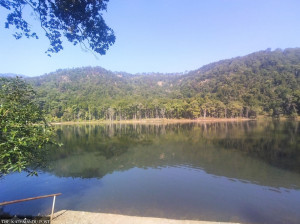Sudurpaschim Province
Chure foothills in Sudurpaschim are parched as natural water sources dry up
Deforestation, haphazard construction activities and undue extraction of riverbed materials are responsible, say experts.
Mohan Budhaair
Several settlements on the southern slopes of the Chure hills in Kailali district in Sudurpaschim province have become parched in the past few years.
The paddy fields, once irrigated by traditional channels and canals throughout the year, have turned barren. Dhanadi village was named so since the vast expanse of the village was famous for high paddy yield until a few years ago. Dhanadi in Nepali translates to areas where paddy is produced.
Farmers in the village, situated in Mohanyal Rural Municipality-7 in the Chure hills, used to grow paddy in huge amounts and paddy was the main source of income for most families in the village. However, of late paddy fields have turned barren since paddy requires plenty of water and because of the drying up of natural water sources in the Chure hills, paddy growing has become a thing of the past.
The locals of the area say that road construction through the Chure forest amid unplanned urbanisation has led to a drought-like situation in Dhanadi and surrounding areas.
“The haphazard construction of roads using bulldozers triggered landslides in the rainy seasons. The massive landslides which buried the water sources of irrigation canals could not be cleared,” Dinesh Gharti Magar of Dhanadi told the Post. “The paddy fields in Dhanadi are parched and nothing grows there anymore.”
The local government had opened a track through the Chure forest to connect Khimadi, the administrative centre of Mohanyal Rural Municipality, to the national road network three years ago. Some natural sources of water completely dried up while others are gradually drying up in the area mainly due to the unplanned development activities.
According to the villagers, the once lush paddy fields have been turned arid; the traditional water mill used to grind grains was closed and the settlement is reeling under an acute shortage of drinking. The development activities were conducted without conserving the natural sources of water, says Gharti Magar. “We have a water crisis now, especially in the dry season. We have to walk for hours to go to the nearest water source to bring drinking water,” he said.
The same story is playing out in Dharmapani, another settlement in the Chure region of Mohanyal. Jaya Singh Dhami, a local resident, is thinking of leaving the settlement owing to the burdening drinking water crisis. “I had migrated here from my ancestral village in Purchaudi of Baitadi district 21 years ago. I moved here because Dharmapani had plenty of water, forest resources and space for animal rearing. It is also near the Tarai region. I never imagined life would be hard here. There is no water left now,” said Dhami.
The construction of a rural road began near Dhami’s house five years ago. The forest area was gradually encroached upon with the increase in human activities. Human settlements expanded and the local topography could not keep up with the change. “Now we have to walk for an hour and a half to fetch drinking water from Kuyapani,” said Dhami.
Several settlements in the Chure region have been greatly affected as natural sources of water are gradually drying up. According to experts, deforestation, haphazard construction of roads using heavy machinery and rampant extraction of riverbed materials in the Chure region are the main reasons behind the worsening water crisis in the area. They are of the opinion that the groundwater level has also decreased sharply in Chure and Tarai regions due to the problems.
According to the Water Supply and Sanitation Division Office in Dhangadhi, water taps of various drinking water projects run by the gravity-flow water system have started to dry up in Nigali, Pandaun, Khairala, Mohanyal, Sahajpur, Godawari, Sungarkhal among other settlements in the Chure region. The engineers at the office informed that the underground water level has decreased in various places of Gauriganga, Ghodaghodi, Bardagoriya and Lamki Chuha in Tarai.

Nagendra Prasad Yadav, a forest environment expert, said that several settlements in the Chure and the Tarai are at high risk of soil erosion and water shortage due to the unplanned road construction, deforestation and excessive extraction of riverbeds materials in the area.
“Natural sources of water originating from the foothills of Chure are gradually drying up in the last few years. The first layer of the underground water in Bhawar (the area between Chure and the Tarai) has dried up now,” said Yadav. He warns about the future of the Tarai region if the deterioration of the Chure range continues. “The fertile Tarai belt could turn into a desert unless rampant extraction of riverbed materials and deforestation are controlled in the Chure region,” he said.
According to him, the destruction of the Chure region in Kailali and Kanchanpur districts of Sudurpaschim Province is worse compared to the other parts of Chure in the country.
Tarai region, as conservation experts claim, is also at a high risk of floods and inundation during the rainy season. Bijaya Shrestha, an ecologist, said that the beds of the rivers and streams have risen in recent years due to increased siltation. “The rivers and streams were about 5-10 metres wide until two decades ago. They are as wide as 500 metres now,” said Shrestha, asserting that the rampant deforestation and haphazard extraction of riverbed materials in the Chure region are the main causes of floods and inundation in Tarai districts.
According to him, the flooded streams like Khutiya, Gauriganga, Pathariya, Kada among others destroy cultivable land in Kailali every rainy season.
The excessive extraction of sands and pebbles goes unchecked in the Godawari, Khutiya, Gauriganga, Khaniya, Machheli and Bagun among other rivers and streams in Kailali.

The local units have awarded contracts to various companies for the extraction of riverbed materials.
“The local units do not take sustainable approaches nor do they have environment-friendly plans and policies to protect the Chure area,” said forest and environment expert Ramesh Chand. “They are more eager to make short-term gains at the expense of the environment, and allow haphazard extraction of riverbed materials in the fragile Chure area. They don’t even monitor whether the contractors are abiding by the environmental impact assessment as they excavate riverbed materials,” he said.
According to Chand, the Chure region is being destroyed due to unplanned development activities such as the construction of roads, drinking water and irrigation projects in the area. Chure and Mohanyal rural municipalities lie in the Chure region of Kailali district. Both local units have prioritised road construction in their annual budgets. Chure Rural Municipality commenced road construction in Sahajpur, Aalad, Deurali, Mauri, Chaumala and Phaltude areas while Mohanyal has five road projects in the Chure region.




 14.12°C Kathmandu
14.12°C Kathmandu












